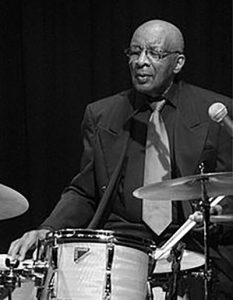PAS Hall of Fame:
Ed Thigpen
(b. December 28, 1930 - d. January 13, 2010)
by Rick Mattingly

“That was awesome,” DeJohnette says, recalling the night. “Ed was in great form. When you play with musicians, it’s always different than just listening to them. I felt very comfortable playing with Ed, and it was obvious why he’s hired and loved and respected by so many great musicians. His time is right there, he listens really well, he’s very musical. It felt natural playing with him, and it was also very inspiring.”
One can certainly contend that Thigpen “gets it honest.” He was born in Chicago in 1930, the son of jazz drummer Ben Thigpen, who was highly regarded for his work with bandleader/bassist Andy Kirk. “My father was a great man as well as a great drummer, respected by his peers,” Thigpen told Ed Soph in a 1985 Percussive Notes interview. “He was known for having good, swinging time. He was a great showman as well as a drummer.”
After his parents separated, Ed moved with his mother to Los Angeles, where he studied piano, sang in a church choir, took dancing lessons, and played drums in his school band. “There was so much music,” Thigpen told Soph. “Even in the third and fourth grades the teachers would play music for us. It was a way of life, a part of community activity. When you are raised in an environment which includes the elements of jazz music–this democratic music, as Max Roach calls it; this music which at its best is individuality, freedom with discipline–of course you are influenced in how you play.”
Thigpen’s first professional gig was with Buddy Collette when Ed was eighteen, and he soon joined the Jackson Brothers show band. He then worked with Cootie Williams at the Savoy Ballroom in New York for several months before becoming a drummer in the Army band for two years.
After his discharge from the service, Thigpen returned to New York and began working with a variety of artists, beginning with singer Dinah Washington and including Johnny Hodges, Bud Powell, Lennie Tristano, and Billy Taylor. During the 1950s he also recorded with Toshiko Akiyoshi, Ira Sullivan, Mal Waldron, Mundell Lowe, Eddie “Cleanhead” Vinson, Teddy Charles, and Blossom Dearie.
During that time, Thigpen became highly regarded for his brush playing and his strong sense of swing. “Brush technique was very important then,” Ed commented recently. “I always played brushes with the snares turned off to get a more harmonic sound coming through the open snare drum. I also learned that volume and intensity were not the same thing. Jo Jones did a great deal for me when I first came to New York, and he used to tell me, `Make it sound as big as possible. Not loud, but big, and as musical as possible.’”
In 1959 Thigpen joined the Oscar Peterson Trio, which included bassist Ray Brown. “That trio put me on the international map,” Thigpen says. “We put out so much material, and a lot of that material still holds up. People come up to me now and say, `I have some of your records,’ and they pull out the Oscar Peterson records.”
In a 1982 Modern Drummer interview, Thigpen said that Peterson set a very high standard. “We had a philosophy that we were going to play so good every night that even on a bad night we’d be head and shoulders above everyone else.
“Working with the trio gave me an opportunity to develop certain elements of my playing,” he explained. “I had a chance to develop a cymbal technique and a method of phrasing which simulated a big band situation. I learned how to listen to the melody and how to phrase with the improvised line to give the feeling that other things were happening. It was complementary, but it was still time, which is what Oscar wanted. I was there to play time and make it swing.”
Thigpen recalled working specifically on time playing with Brown. “Ray and I roomed together,” Ed said. “When I first joined the group, Ray said, `Okay, we’re gonna practice time–just the two of us.’ And we did. I figured it would last about a week or so. Well, a year later we were still practicing time. We’d wake up in the morning and practice time. We’d practice dynamics, tempos, and singing the tunes we played. We got to the point where we could recite our name and address as we were playing time and know where we were in the tune at all times.”
Of the many recordings Thigpen made with the Peterson Trio, he cites West Side Story as being one of the best, and the most difficult. He also recalls a drum fill on the tune “Judy” from the album The Oscar Peterson Trio and Nelson Riddle. “I played the best two-beat solo you ever heard–or at least that I ever heard,” Ed says, laughing. “When I finished, I yelled out, `Hey Buddy, did you hear that?’”
After leaving Peterson in 1965, Thigpen worked with singer Ella Fitzgerald for a year. “Working with Ella, with Tommy Flanagan on piano, was one of the highlights of my life,” Ed says. “She sounded like an orchestra, so you could draw on everything with her. I would use cymbal shadings and glissandos and swells–all of the percussive effects you would use with a full orchestra.”
After moving to Los Angeles and working freelance for a year, Thigpen worked with Fitzgerald again from 1968 to 1972, and then he moved to Copenhagen after marrying a woman from Denmark. Ed became very active in the European jazz scene, and he recorded with a wide variety of artists, including Toots Thielemans, Johnny Griffin, Horace Parlan, Helen Humes, Clark Terry, Kai Winding, Thad Jones, Benny Carter, Art Farmer, and Monty Alexander.
In addition, Thigpen has led his own groups over the past two decades and released a number of fine albums, including Mr. Taste, It’s Entertainment, and the recent Element of Swing, which features saxophonist Joe Lovano.
Thigpen has also been active as an educator. His book The Sound of Brushes is considered a definitive resource on the art of brush playing, and his Rhythm Analysis and Basic Coordination for Drums has found favor with many teachers and students. He has also taught extensively in Copenhagen and given countless clinics around the world.
In his clinics, Thigpen stresses the fundamentals of drumset playing, such as maintaining a pulse on the bass drum. “It’s a misconception that with the advent of bebop the bass drum was no longer played with a steady pulse–that the time moved up to the ride cymbal,” Thigpen said in his Percussive Notes interview. “Kenny Clarke himself says that isn’t so. This misinformation has been given to a generation and a half and, consequently, when you hear the band play you don’t hear or feel that bottom.
“Even in high school we argued about it. Then I saw Max Roach in New York and he played the bass drum, 1-2-3-4. I asked my father, and Jo Jones, and Sid Catlett. They said you `feather’ the bass drum. You have a pulse that is felt. You don’t beat it; you just feather it. And when you want a `bomb,’ you just bring that beater back and hit the drum with a big, loud stroke. Then you get back to the pulse, because with that you can hold the band together.
“Playing the bass drum is part of the heritage and should be part of the training that goes into learning how to play the set, because it is fundamental to the instrument. Once these fundamental rules have been mastered, then you can take liberties and know how and why you are doing what you’re doing. The set has been taught in a wrong manner because of this particular misconception of the role of the bass drum. It’s like going for the roof before putting down the foundation. There are certain basic truths about this instrument, which are not being put into perspective.”
But although Thigpen is firmly grounded in tradition, he has always been one to adapt to the times. “When Tony Williams came in with 4/4 on the hi-hat, I had to work like a dog to learn how to do that,” Thigpen admits. “But guys like Tony and Jack DeJohnette were always very encouraging and helpful when I would ask them about things they were doing.”
DeJohnette considers Thigpen to be quite youthful in his attitude. “Ed is always trying new things,” DeJohnette says. “He’s never afraid to ask questions, and he’s always looking for new ways to enhance his playing style, which is quite masterful and tasteful. He’s one of the most beautiful human beings I know, and I’m glad to see him being honored with the PAS Hall of Fame award.”
“I’ve always felt I’ve been a member of a luxury profession,” Thigpen told Modern Drummer. “I’m thankful I’ve had the opportunity to be a part of it. Just the idea of playing music–the rapport between a group of musicians when that magic happens, the gratification when it works. You can’t put a dollar sign on the love and joy one receives out of being able to participate. To my way of thinking, it’s about as close to heaven as one is going to get on this earth.”









